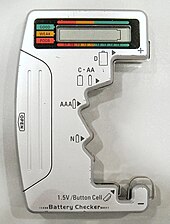battery capacity
Battery Capacity and discharge
The battery capacity is the amount of electric charge it can deliver at the rated voltage. The more electrode material contained in the cell the greater its capacity. A small cell has less capacity than a larger cell with the same chemistry, although they develop the same open-circuit voltage.[30] Capacity is measured in units such as amp-hour (A·h).
The rated battery capacity is usually expressed as the product of 20 hours multiplied by the current that a new battery can consistently supply for 20 hours at 68 °F (20 °C), while remaining above a specified terminal voltage per cell. For example, a battery rated at 100 A·h can deliver 5 A over a 20-hour period at room temperature.
The fraction of the stored charge that a battery can deliver depends on multiple factors, including battery chemistry, the rate at which the charge is delivered (current), the required terminal voltage, the storage period, ambient temperature and other factors.[30]
The higher the discharge rate, the lower the capacity.[31] The relationship between current, discharge time and capacity for a lead acid battery is approximated (over a typical range of current values) by Peukert’s law:
- {displaystyle t={frac {Q_{P}}{I^{k}}}}
where
- {displaystyle Q_{P}}
is the capacity when discharged at a rate of 1 amp.
- {displaystyle I}
is the current drawn from battery (A).
- {displaystyle t}
is the amount of time (in hours) that a battery can sustain.
- {displaystyle k}
is a constant around 1.3.
Batteries that are stored for a long period or that are discharged at a small fraction of the capacity lose capacity due to the presence of generally irreversible side reactions that consume charge carriers without producing current. This phenomenon is known as internal self-discharge. Further, when batteries are recharged, additional side reactions can occur, reducing capacity for subsequent discharges. After enough recharges, in essence all capacity is lost and the battery stops producing power.
Internal energy losses and limitations on the rate that ions pass through the electrolyte cause battery efficiency to vary. Above a minimum threshold, discharging at a low rate delivers more of the battery’s capacity than at a higher rate.
Installing batteries with varying A·h ratings does not affect device operation (although it may affect the operation interval) rated for a specific voltage unless load limits are exceeded. High-drain loads such as digital cameras can reduce total capacity, as happens with alkaline batteries. For example, a battery rated at 2 A·h for a 10- or 20-hour discharge would not sustain a current of 1 A for a full two hours as its stated capacity implies.
C rate
The C-rate is a measure of the rate at which a battery is being discharged. It is defined as the discharge current divided by the theoretical current draw under which the battery would deliver its nominal rated capacity in one hour.[32] A 1C discharge rate would deliver the battery’s rated capacity in 1 hour. A 2C discharge rate means it will discharge twice as fast (30 minutes). A 1C discharge rate on a 1.6 Ah battery means a discharge current of 1.6 A. A 2C rate would mean a discharge current of 3.2 A. Standards for rechargeable batteries generally rate the capacity over a 4-hour, 8 hour or longer discharge time. Because of internal resistance loss and the chemical processes inside the cells, a battery rarely delivers nameplate rated capacity in only one hour. Types intended for special purposes, such as in a computer uninterruptible power supply, may be rated by manufacturers for discharge periods much less than one hour.
Fast-charging, large and light batteries
As of 2012, lithium iron phosphate (LiFePO
4) battery technology was the fastest-charging/discharging, fully discharging in 10–20 seconds.[33]
As of 2013, the world’s largest battery was in Hebei Province, China. It stored 36 megawatt-hours of electricity at a cost of $500 million.[34] Another large battery, composed of Ni–Cd cells, was in Fairbanks, Alaska. It covered 2,000 square metres (22,000 sq ft)—bigger than a football pitch—and weighed 1,300 tonnes. It was manufactured by ABB to provide backup power in the event of a blackout. The battery can provide 40 megawatts of power for up to seven minutes.[35] Sodium–sulfur batteries have been used to storewind power.[36] A 4.4 megawatt-hour battery system that can deliver 11 megawatts for 25 minutes stabilizes the output of the Auwahi wind farm in Hawaii.[37] Lithium–sulfur batteries were used on the longest and highest solar-powered flight.[38] The recharging speed of lithium-ion batteries can be increased by manufacturing changes.[39]

